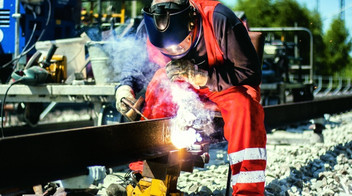Development of the infrastructure
Capacity and frequency management
The importance of capacity management for stations in Germany is steadily increasing. To facilitate the forecast growth in passenger numbers, the performance capability of the stations must be ensured and enhanced by means of suitable measures. Germany in sync is a key factor in the 2040 passenger forecast, which is used as the basis for estimating any capacity requirements for the stations.
Since 2021, close to 280 stations have already been analyzed by means of a capacity check. The capacity checks were used to identify capacity-related obstacles and bottlenecks in a standardized manner and measures were introduced to eliminate them. Some short-term measures have already been successfully implemented, such as the clearing of platforms.
In the course of the capacity checks, macroscopic and microscopic passenger flow analyses were carried out to simulate passenger flows at the station, in line with the level of detail required. If construction projects or measures are scheduled for a station, their impact and effects on passenger flows can be estimated using scenarios.
By piloting so called high-performance platforms in Mannheim central station, Hamburg central station and Frankfurt-Galluswarte, we are investigating the optimal utilization of existing platform areas. By clearing the platforms and applying a standardized system of organization to all platforms, it should be possible to make better use of the existing circulation areas and thus improve the distribution of passengers on the platforms. This is intended to prevent bottlenecks and overcrowding. In addition, ceiling and floor coverings have been installed and the signage has been replaced and
expanded.
The frequency management system is an important tool for identifying capacity bottlenecks. Real-time measurement using video technology makes it possible to detect an increase in passenger volumes at an early stage and take appropriate measures to prevent acute overcrowding. In addition to real-time measurement to prevent overcrowding, the video data can be used to derive longer-term measures or verify their effect. In cases of doubt, this means that partially extensive and cost-intensive structural measures can be avoided. As of December 31, 2023, 28 stations had been equipped with a frequency management system. During the rollout, we plan to equip a total of 100 stations with a frequency management system.
Modernization, commissioning and construction of stations
- Dortmund central station: After completion of the modernization (expected in the first quarter of 2025), the station will have full step-free access and will enable the fully accessible linkage of different means of transport. At the end of April 2023, the fifth of the eight platforms undergoing modernization went back into operation after less than a year of construction, with the sixth platform following in December 2023.
- Duisburg central station: Work has been ongoing since mid-2022 to renovate all platforms and build the new hall roof at Duisburg central station. The concept involves the platform-by-platform dismantling of the existing roof and simultaneous reconstruction of the curved, wave-shaped glass roof, known as the Duisburg Wave, as well as the associated platforms. In mid-July 2023, the first of the six platforms, including the new hall roof, was approved for service again after the reconstruction. According to current planning, the entire project, which will also see a large proportion of the overhead wire around the central station renewed, will run until 2028.
- Hanover central station: Beginning in summer 2022, all the platforms, platform roofs and some bridge structures above the passenger tunnel level are being gradually renovated at Hanover central station. Work on the first platform began in summer 2022 and is due to be completed by early 2024. Plans are also in place to start renovating the second platform in 2024. As the construction work on the platforms is being concentrated around the summer vacation period of each year for operational reasons, the renovation of all six platforms and associated facilities is not expected to be completed until after 2033.
- Berlin East station: Construction work on the hall roof at the East station in Berlin is progressing as scheduled. Since May 2021, scaffolding platforms have been set up to renovate the entire roof membrane, install new skylights and renew the corrosion protection on all of the roof girders. Thanks to the chosen form of construction, train and passenger traffic can be maintained almost continuously while work on the roof is being carried out. The key measures are expected to be completed by the end of 2024.
- Hamburg-Altona station: The terminal station for long-distance and regional transport in Hamburg-Altona is being moved and becomes a stopping point. The current Diebsteich S-Bahn (metro) station will be expanded to become a through station. A total of four platforms and a concourse building will be constructed. Work has already begun. The platform for the S-Bahn (metro) will be in operation by August 2024. The three long-distance and regional railway platforms are not likely to be completed until after 2027, as the connecting tunnel currently under discussion in Hamburg would have an impact on the location of and links to the new station.


